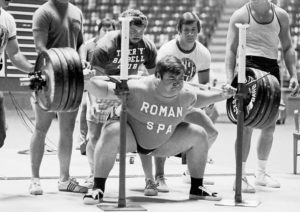
Strength Sensei Bookshelf
The Squat Bible
If you’re looking for a hardcore training manual that will enable you to slap another pair of 45-pound bumper plates to your squat max in just five weeks, The Squat Bible is not for you. If you’re looking for answers to your questions about how to incorporate bands and chains into your squat workouts, The Squat Bible is not for you. But if you’re new to weight training, or have aspirations of becoming a personal trainer or strength coach, The Squat Bible is definitely for you!
The Squat Bible was written by Dr. Arron Horschig (the primary author), Dr. Kevin Sonthana, and Travis Neff. The subtitle of this 127-page book is, “The Ultimate Guide to Mastering the Squat and Finding Your True Strength.” Sorry, but you’ll be disappointed if you expect this book to be the only resource you’ll ever need on the subject of squatting. You’ll also be disappointed to find that the book doesn’t include any workouts.
Now that you know what The Squat Bible can’t promise and doesn’t offer, let’s look at what it does have and make the case as to why you need a copy of it in your strength training library .

The focus of Horschig’s book is what he calls “movement competence,” which he says, “creates a foundation for which strength and skill are predicated upon.” Horschig, who has a doctorate in physical therapy, says movement competence involves being able to demonstrate proficiency in fundamental and functional movement patterns, “such as our ability to perform a deep squat with correct joint alignment and muscular coordination.”
Horschig teaches movement competence for the squat by focusing on principles he calls the “Five Absolutes of Squatting.” A practical teaching method for beginners, here are the five parts of his approach:
1. Toe Angle
2. The Tripod Foot
3. Hip Hinge
4. Creating External Rotation
5. Postural Integrity
From this starting point, the reader is treated to detailed instructions on how to perform the bodyweight squat, high-bar back squat, low-bar back squat, front squat, and the overhead squat. Horschig’s instructions are written for a general audience, and he supports his teachings with quality photos. The remainder of the book focuses on identifying problems in squatting
technique and how to correct them. The main areas of focus, each getting a chapter, are the foot, ankle, knee, and hip.
If you’re not sold yet, consider that The Squat Bible is packed with answers to many common questions about squatting, such as how to breathe while squatting and, of course, “Are Deep Squats Bad for Your Knees?”
For those who want to take their squat education to the next level, Horschig offers Chapter 12: The Real Science of the Squat, which dumbs down confusing biomechanical terms such as force, torque, and lever arms. And if you don’t take what the authors say in The Squat Bible as gospel, extensive references are provided throughout the book. If you’re new to weight training and don’t know squat about the squat, pick up a copy of The Squat Bible. If you are already squatting and want to refine
your technique, or have a coaching position where you teach the squat, you’re sure to find many practical tips in The Squat Bible that will make it a wise investment.
Lead photo by Bruce Klemens
For monthly programming and access to a private Facebook group where you can ask all of your coaching & training questions, join the Dojo of Strength. To learn techniques that Charles Poliquin used to coach over 26 Olympic medalists, sign up for an upcoming seminar or e-course.
